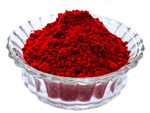|

Tilak or Pottu are religious markings applied on the forehead (even on the upper part of the head) by both men and women. It could be a powder, paste or liquid and is traditionally used for religious reasons and for pujas. It could consist of white/grey ashes/vibhuti, yellow turmeric/haldi, red/green (kuber)/black colour and/or sandalwood paste/gandha.
Kumkum which is red in colour is commonly applied between the eyebrows on the Ajna chakra (the third eye or mind’s eye) by most women, whereas Sindoor is applied by them where their hair is parted.
Kumkum is usually made from 95% dried & powdered turmeric and 5% slaked lime (calcium hydroxide of mineral origin) & pure camphor, or by treating the turmeric with alkali so that yellow colour turns to red.
Kumkum could also be made from sago/maize/rice powder/starch mixed with coal tar colours (mineral origin). Red sandalwood powder is utilised in some.
Kumkum or Sindoor made from saffron is considered the purest and best but it is costly.
Screwpine flower or Thalampoo fragrance red and also green Kumkum is made in Madurai.
Kumkum is often adulterated with lead tetroxide/minium (Pb3O4) which is a bright red or orange pigment used in the manufacture of batteries and rustproof primer paints. No wonder it causes serious adverse effects on human health when used as an ingredient of Kumkum or Sindoor.
Sindoor is traditionally a mixture of turmeric and alum or lime juice. However, most of what is available for sale is toxic because it is basically vermillion or Puja Roli which is made from cinnabar or mercury sulphide to which Pb3O4 has been added.
The Bindi which comes in various shapes, styles and colours is a sticker worn in place of Kumkum. A Bindi allergy or contact dermatitis (problems like redness and itchiness) is mainly due to the use of PTBP (Para Tertiary Butyl Phenol) formaldehyde resin and/or the use of beeswax. (PTBP is used to bond leather and rubber, particularly shoes.)
Animal derived ingredients in Kumkum and Sindoor could be ghee, shellac and beeswax.
Alta, the red colour used for painting feet and palms that is similar to Mehendi is traditionally made from betel leaves, but like Sindoor chemical versions are unsuspectingly bought. In addition it could very well contain shellac.
Mehendi consists of powdered henna leaves (which release an orange dye when crushed), water, lemon/jagua fruit juice, essential oils and sugar. Para-phenylenediamine, a chemical is added by manufacturers to make it darker. White henna is actually body paint.
Intricate Mehendi designs on hands and feet are traditional for Indians. Mehendi is also used to dye hair which turns orange and thereafter Indigo (plant origin) is applied to turn the hair black.
Rangoli is usually powdered quartz, dry or wet powdered rice or dry flour to which natural or synthetic colours have been added. In addition red brick powder and flower petals could also be used to make pretty patterns on the floor or ground on auspicious days.
Chawk is similar to rangoli but applied via design perforated metal boxes on either side at the entrance of doors, and is powdered calcium carbonate of mineral origin e.g. limestone.
|